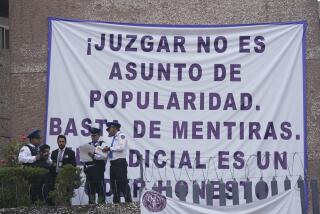Zedillo Plan Criticized as Too Little, Too Late : Mexico: Analysts say profit cuts will further hurt stocks. The outflow of foreign capital bodes severe recession ahead.
- Share via
MEXICO CITY — President Ernesto Zedillo’s economic rescue plan is unlikely to restore foreign investor confidence enough to prevent a severe downturn, many investors and analysts said Tuesday.
The plan, announced Tuesday, will severely reduce the profits of Mexican companies, so their stocks will be much less attractive, they said. Zedillo’s plan also provides for no relief for Mexican companies whose debts have skyrocketed because they must pay them in dollars, they said.
In addition, investors and analysts were critical that Zedillo did not present a plan for action until three weeks after the devaluation of the peso, saying that this raises questions about his ability to lead.
And failure to regain investor confidence is likely to push the economy further into a downward spiral of recession, inflation and further devaluation, investors said.
On Tuesday, the Mexican Stock Exchange reflected that lack of investor confidence. The index plunged 75.77 points, or 3.22%, after leaks about the plan, and it was expected to fall further today.
“A lot of people feel like they’ve been burned, and there is still a lot of downside potential to the Mexican market,” said Paul White, who heads emerging-markets investments for Los Angeles-based Arco Investment Management.
Mexico needs to bring back investors--or at least keep more of them from leaving--to avoid a repeat of the downward spiral it suffered in 1982, when a debt crisis provoked an outflow of foreign capital that plunged the economy into severe recession.
Investor opinion is crucial because Mexico has relied on record levels of foreign investment--$33 billion in 1993--to finance growth. As long as money flowed in, the government could use foreign capital to offset money leaving the country as a result of the burgeoning trade deficit brought on by free-market reforms and lower import tariffs.
However, 85% of the foreign capital has been “hot money”--investments in stocks and bonds that could easily be sold. And that capital began to leave in droves last month, with investors pulling an estimated $10 billion out of Mexico. In the process, the peso lost 30% of its value, and investors who stayed lost billions of dollars. Foreign reserves fell to $6.1 billion from $20 billion early in the year, while the government tried in vain to defend the currency.
The fragility of the government’s reliance on foreign capital is illustrated in the case of tesobonos --dollar-denominated bonds the government had offered as a hedge against a peso devaluation. About $3.6 billion worth of the bonds come due in January and $10 billion in the first quarter. All must be paid in dollars.
“With $6 billion in reserves, they don’t have enough to cover the maturities in the first quarter,” said Mauro Leos, vice president at Cimex-Wefa, a Philadelphia-based economic analysis firm.
And if Mexico is forced to draw on the $18-billion financial package promised by Mexico’s major trading partners and commercial banks to help the country pay off tesobono holders, it will further erode confidence, noted Mexico City economist Rogelio Ramirez de la O.
By all accounts, the Zedillo administration is trying to do everything it can to restore investor confidence. Government officials were scheduled to begin meeting with selected foreign investor groups in the United States and Europe today to explain the plan.
Restoring that confidence will be a slow process, investors and analysts said. They were divided as to whether Zedillo’s proposals represented even a step in the right direction.
Investors were critical of the plan, which openly calls on Mexican companies to cut their profits in exchange for labor unions agreeing to keep down wage demands. Sources close to the negotiations said business leaders made that concession to avoid outright price controls, but it will make the companies very unattractive as investments.
“I am concerned that the line will be held on prices at the consumer level and not at the input level,” said Kristi King-Etchberger, an analyst at D.A. Campbell Associates in Santa Monica. “It is hard to control all prices, and those most effectively controlled are consumer prices. That puts the ultimate producer in a squeeze.”
Breweries, such as Modelo, maker of Corona beer, and soft drink manufacturers could be particularly vulnerable.
Also, critics said, the plan makes no provision for helping Mexican corporations that are trying to pay off dollar-denominated debts, which rose 30% with the devaluation.
Many industrialists, such as Cementos de Mexico, took dollar-denominated loans to finance the expansion and modernizing needed to compete under new free-market policies. And rates on peso debt were prohibitive. After the 1982 crisis, Zedillo was in charge of a government fund that helped corporations in similar situations and is credited with saving many.
Some businesses had expected Zedillo’s plan to have similar provisions, but analysts said most companies with big dollar debt now also have dollar revenues.
* NATIONAL SACRIFICE
Zedillo unveils austerity plan. A1
* BAD BETS
Peso trades hit Chemical Banking. D2
More to Read
Sign up for Essential California
The most important California stories and recommendations in your inbox every morning.
You may occasionally receive promotional content from the Los Angeles Times.













